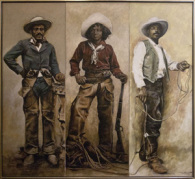Black Cowboys
The history of the Black cowboy began long before the establishment of large ranches with cattle grazing in the late nineteenth century.
The Gambia and some other African countries were known to be lands of large cattle herds with the natives possessing innate skills in controlling and managing the movement of the animals. They were not called cowboys at that time, but merely herders.
Throughout the slave trade, ranchers and farmers (slave owners) with large herds of cattle in the lower south were attracted to these particular groups that had been captured from those African countries.

Once purchased prior to the Civil War, the slaves began to hunt and work cattle in the tall grass, pine barrens, and marshes of South Carolina and other sections of the Lower South in gangs on what was then called cattle plantations.
A few were mounted, but most were on foot and used dogs, bullwhips, and salt to manage cattle. The pine barrens extended westward through Georgia and northern Florida, the Gulf of Mexico, Southern Alabama, Mississippi, Louisiana, and into the grazing lands of Southeast Texas.
As more and more cattle farmers moved westward with their herds and slaves, more and more slaves escaped into the northern states of Mexico, between the Sierra Madres where the principal occupation was cattle and sheep raising.
The ex-slaves swapped skills with the Vaqueros. They taught the Vaqueros the skills of controlling cattle, and the vaqueros taught the ex-slaves the skills of horseback riding and roping. From this group came some of the best cowboys to work the ranches in Texas, and to ride the cattle trail northward.
Another centre of Black cowboys prior to the movements westward to Texas was in the Savannahs of Southern Florida. This group was made up mostly of black runaways from the plantations in Georgia and South Carolina into the Seminole Indian Nation. They became herdsmen on foot and horseback. Many in this group went to Oklahoma with the Seminoles, and subsequently with their leader, John Horse and the Seminole Chief Wild Cat, to Mexico where their skills were used in herding cattle as well as fighting with the Mexican army
Probably the largest contingent of Black cowboys just prior to and immediately after the Civil War could be found in the wide coastal prairie of coarse grass, groves of trees, wooded creeks, and bayous along the Gulf below Houston, Texas from the Guadalupe River eastward to Louisiana.
After Emancipation and the Civil War, thousands of Blacks went to work on the ranches throughout south and west Texas, and subsequently rode the cattle trails northward. To name a few and one of the most famous was Bose Ikard. Born a slave in Mississippi in 1847, Bose was brought to Texas when he was five years old by the Ikard family.
Growing up on the frontier, he learned to ride, rope and fight. These skills made him a valuable cowhand later. He rode with such cattlemen as Charles Goodnight, Oliver Loving, John Chisum and John Slaughter as they went north from Texas with thousands of cattle over deserts, through Apache, Sioux and Comanche Indian territory and army posts into the Wyoming ranges.

Another Black cowboy who rode the Goodnight-Loving Trail was Jim Fowler. He was assigned the worst job, of shooting calves in the morning that had dropped during the night. (NB: Supposedly the story for the movie "Red River," an American Classic was based on the Goodnight-Loving Trail. However, not one Black cowboy was portrayed.)
Jim Perry was an all-around cowboy, cook and fiddler who worked on the XIT ranch. He once remarked: “If it weren’t for my damned old black face I’d have been boss of one of these divisions long ago.” Newt Clendenen was another well-known cowboy that worked on the XIT ranch.
‘One Horse Charley’ was yet another noted black cowboy who rode with the Shoshone Indians.
Ben Hodges rode north in a cattle drive from Texas and stopped off at Dodge City, Kansas. A card cheat, fast-talking confidence man, and cattle thief, Ben was one of the few men who survived the wild and dangerous Dodge City.
He died in 1929 and was buried in the Maple Grove Cemetery among many old-time cattlemen and cowboys. “We buried Ben there for a good reason,” one of his friends and pallbearers remarked. “We wanted him where they could keep an eye on him.”
There were many others, famous and not so famous, such as Nat Love, Jesse Stahl, Bill Pickett, Isom Dart, and thousand of others who rode away into the sunset following the heyday of the cattle trails.
Most were known only by their first names or nicknames. Some drifted onto the ranches and worked throughout the western frontier. Of the estimated 35,000 cowboys that worked the ranches and rode the trails, between five to nine thousand or more were said to have been Black. They participated in almost all of the drives northward, and were assigned to every job except that of trail boss. One historian noted that there had been a few cattle drives where the entire crews were black except for the trail boss.
During the latter years of the twentieth century Blas Payne was considered to be the finest cowboy ever to ride a horse in the Big Bend country of Southwest Texas.
Blas was the grandson of Trumpeter Isaac Payne, a Seminole-Negro Indian Scout, who was awarded the Congressional Medal of Honour. He worked on the Combs Ranch east of Alpine, Texas and, along with other cowboys became noted and respected for their horsemanship and livestock skills.
Fred Fay, whom I had the pleasure of meeting, resides in Brackettville, Texas.
He died recently having been a cowboy, bronco-rider, sheep and goat herder. Former caretaker of the Seminole Indian Cemetery, he was born in Mexico of African, Mexican, and Seminole ancestry, and came to west Texas at a very young age. His father, Andrew Fay, was also a cowboy who worked on various ranches in southwest Texas for many years.


